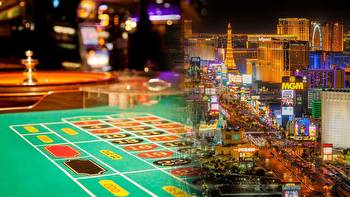Post-Pandemic Shifts in Las Vegas Casino Games

Gambling in Las Vegas casinos has changed a lot over the years. Since the COVID-19 pandemic, there’ve been a slew of changes to the gaming floor.
Some advancements started before the pandemic and were accelerated during this time. One thing many of the game changes have in common is that casinos have been gradually increasing their advantage over players.
The most noticeable difference on the gaming floor is how they’re configured. This isn’t exactly new but the evolution from long rows of machine games to pods is very noticeable when walking through the casino.
Shift In Table Games
There are still more blackjack games in Nevada casinos than any other. During its last monthly revenue report, the Nevada Gaming Control Board (NGCB) counted 2,067 blackjack games throughout the state.
According to the report, more than half of those tables, 1,120, were at casinos in the Vegas Strip area. There are almost the same number of blackjack tables in these casinos as all other games combined.
While blackjack remains the dominant game in casinos, there are changes to other popular games that players may or may not notice. The Craps and Pai Gow Poker games available for players are changing.
Moving To Face Up Pai Gow
During the COVID-19 pandemic, casinos started to change over to Face Up Pai Gow from the traditional game. The evolution is so drastic that few casinos in Las Vegas even offer the Pai Gow many players grew up with.
The difference between the two games is easily noticeable to experienced players. First, players don’t pay a 5% commission if they win a hand of Face Up Pai Gow. Removing dealers from paying the change from commissions was made specifically when casinos reopened after the peak of the Covid-19 pandemic.
Second, the dealer’s cards are face-up. While players can set their hands in a way to ensure a win, they can also muck up a losing hand.
Instead of paying commission, players will push when the dealer has an Ace (this could be a different card the casino chooses). According to gaming odds website Wizard of Odds, Face Up Pai Gow has a house edge for the casino of 1.81%. While still low, this is much higher than the traditional game.
In addition to the greater house edge, casinos will win more frequently.
The games are played faster, with players mucking losing hands and dealers no longer having to deal with money from commissions because there are more games per hour.
Another change that isn’t noticeable at first glance is casinos changing some craps tables to crapless craps tables. This can be more confusing to craps players than the Pai Gow Poker change. Casinos typically offer both traditional and crapless games next to one another.
The move to crapless craps has been more rapid and started after the COVID-19 pandemic.
Gaming odds expert John Mehaffey reports that crapless craps tables in Las Vegas have surged from two in 2020 to 23 at the start of this year.
It’s no surprise that the casino has a much larger house edge with this game. All craps tables have numerous bets but there’s one difference that stands out between the two games.
According to Wizard of Odds, the house edge on a crapless craps passline bet is 5.382%. The house edge for this wager at a traditional craps table is only 1.41%.
Experienced craps players will notice the table layout is slightly different. There are no “don’t” bets. Additionally, all numbers except “7” are points.
Triple Zero Roulette isn't new. This version of the game was introduced around 2018 at different Vegas Strip casinos.
This variety of roulette has exploded in Las Vegas. It's almost impossible to visit a casino on the Vegas Strip without seeing some kind of roulette game with an extra space and a larger house edge.
Similar to crapless craps, triple zero roulette can be found next to a roulette game with a lower house edge. Casinos often have a lower minimum wager for the roulette game with the larger house edge.
Triple Zero roulette could be marked by a third zero or casino logo slot on the wheel. Either way, this version of roulette has a larger house edge for the casino. The shift from “00” roulette to “000” roulette increases the house edge from 5.26% to 7.89%.
Pre-pandemic Bellagio Casino in Las Vegas, with slot machines lining the floor before COVID-19 introduced new gaming configurations. (Image: ehrlif / Alamy)
Electronic Table Games Constantly Rotating
During the peak of the COVID-19 pandemic, casinos increased the number of electronic table games (ETGs) available. Similar to changing Pai Gow Poker games, this change was made, in part, to reduce the amount of human contact.
The NGCB doesn’t separate ETGs from live dealer games so there’s never an accurate number for the number of games on casino floors and that’s okay. Between ETGs for traditional-style tables, stadium gaming installations for a large number of players, and individual units, the number of games changes often.
ETGs were introduced in Europe in the 1990s. Even though they aren’t new to casino operators, they’ve only become popular in the past five to ten years in the US.
Anecdotally, new players like these games because it’s less intimidating to play against a machine than a human. Casinos typically offer the lowest minimum wagers for these games. For example, the minimum bet at blackjack might be $5–10 for an ETG, while it’s $15–$25 for a live dealer game.
Las Vegas casinos always try to find the right blend of games for their property. Over the past five years, just about every gaming floor has seen different ETG installations of all sizes.
ETGs may be here to stay but the games available are constantly changing. This is similar to casinos changing how many multi-game (video poker, keno, etc.) and traditional slot machines there are.







































